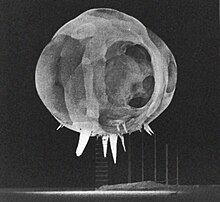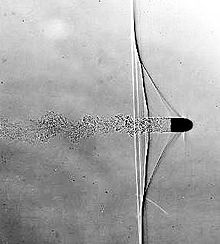Doc Edgerton
Harold Eugene Edgerton | |
|---|---|
| Born | April 6, 1903 |
| Died | January 4, 1990 (aged 86) |
| Alma mater | University of Nebraska-Lincoln (B.S., Electrical Engineering, 1925) Massachusetts Institute of Technology (M.S., Electrical Engineering, 1927; Ph.D., Electrical Engineering, 1931) |
| Known for | Stroboscope |
| Spouse | Esther May Garrett |
| Children | Robert Frank Edgerton William Eugene Edgerton Mary Louise Edgerton |
| Awards | SPIE Gold Medal (1981) |
| Scientific career | |
| Fields | Engineering/photography |
| Institutions | Massachusetts Institute of Technology |
Harold Eugene "Doc" Edgerton also known as Papa Flash (April 6, 1903 – January 4, 1990) was a professor of electrical engineering at the Massachusetts Institute of Technology.[1] He is largely credited with transforming the stroboscope from an obscure laboratory instrument into a common device. He also was deeply involved with the development of sonar and deep-sea photography, and his equipment was used by Jacques Cousteau in searches for shipwrecks and even the Loch Ness monster.[2]
Biography
Early years
Edgerton was born in Fremont, Nebraska, on April 6, 1903, the son of Mary Nettie Coe and Frank Eugene Edgerton,[3][4] a descendant of Richard Edgerton, one of the founders of Norwich, Connecticut and a descendant of Governor William Bradford (1590–1657) of the Plymouth Colony and a passenger on the Mayflower. His father was a lawyer, journalist, author and orator and served as the assistant attorney general of Nebraska from 1911 to 1915. Harold grew up in Aurora, Nebraska. He also spent some of his childhood years in Washington, D.C., and Lincoln, Nebraska.
Education
In 1925 Edgerton received a bachelor's degree in electrical engineering from the University of Nebraska-Lincoln where he became a member of Acacia Fraternity.[5] He earned an S.M. in electrical engineering from MIT in 1927. Edgerton used stroboscopes to study synchronous motors for his Sc.D. thesis in electrical engineering at MIT, awarded in 1931. He credited Charles Stark Draper with inspiring him to photograph everyday objects using electronic flash; the first was a stream of water coming out of a faucet.
Career


In 1937 Edgerton began a lifelong association with photographer Gjon Mili, who used stroboscopic equipment, in particular, multiple studio electronic flash units, to produce strikingly beautiful photographs, many of which appeared in Life Magazine. When taking multiflash photographs this strobe light equipment could flash up to 120 times a second. Edgerton was a pioneer in using short duration electronic flash in photographing fast events photography, subsequently using the technique to capture images of balloons at different stages of their bursting, a bullet during its impact with an apple, or using multiflash to track the motion of a devil stick, for example. He was awarded a bronze medal by the Royal Photographic Society in 1934, the Howard N. Potts Medal from the Franklin Institute in 1941,[6] the David Richardson Medal by the Optical Society of America in 1968,[7] the Albert A. Michelson Medal from the same Franklin Institute in 1969,[8] and the National Medal of Science in 1973.[9]
Edgerton teamed up with Kenneth J. Germeshausen to do consulting work with different industrial clients. Later Herbert Grier joined them. The company name "Edgerton, Germeshausen, and Grier" was changed to EG&G in 1947. EG&G became a prime contractor for the Atomic Energy Commission and had a major role in photographing and recording nuclear tests for the United States through the fifties and sixties. For this role Edgerton and Charles Wykoff and others at EG&G developed and manufactured the Rapatronic camera
His work was instrumental in the development of side-scan sonar technology, used to scan the sea floor for wrecks. Edgerton worked with the undersea explorer Jacques Cousteau, by first providing him with custom designed underwater photographic equipment featuring electronic flash, and then by developing sonar techniques used to discover the Britannic. Edgerton participated in the discovery of the American Civil War battleship USS Monitor. While working with Cousteau, he acquired the nickname he is still known by in photographic circles, "Papa Flash".
In addition to having the scientific and engineering acumen to perfect strobe lighting commercially, Edgerton is equally recognized for his visual aesthetic: many of the striking images he created in illuminating phenomena that occurred too fast for the naked eye adorn art museums worldwide. In 1940, his high speed stroboscopic short film Quicker'n a Wink won an Oscar.[10]
Edgerton was appointed a professor of electrical engineering at the Massachusetts Institute of Technology (MIT) in 1934.[11] In 1956, Edgerton was elected a Fellow of the American Academy of Arts and Sciences.[12] He was especially loved by MIT students for his willingness to teach and his kindness: "The trick to education", he said, "is to teach people in such a way that they don't realize they're learning until it's too late". His last undergraduate class, taught during fall semester 1977, was a freshman seminar titled "Bird and Insect Photography". One of the graduate student dormitories at MIT carries his name.
In 1962, Dr. Edgerton appeared on I've Got a Secret, where he demonstrated strobe flash photography by shooting a bullet into a playing card and photographing the result.
Edgerton's work was featured in an October 1987 National Geographic Magazine article entitled "Doc Edgerton: the man who made time stand still".
Family
After graduating from the University of Nebraska-Lincoln, Edgerton married Esther May Garrett[13] in 1928. She was born in Hamilton County, Nebraska on September 8, 1903 and died on March 9, 2002 in Charlestown, South Carolina. She received a bachelor's degree in mathematics, music and education from the University of Nebraska-Lincoln. A skilled pianist and singer, she attended the New England Conservatory of Music and taught in public schools in Aurora, Nebraska and Boston. During their marriage they had three children: Mary Louise (4/21/1931), William Eugene (8/9/1933), Robert Frank (5/10/1935). His sister, Mary Ellen Edgerton, was the wife of L. Welch Pogue (1899–2003) a pioneering aviation attorney and Chairman of the old Civil Aeronautics Board. David Pogue, a technology writer, journalist and commentator, is his great nephew.
Death
Edgerton remained active throughout his later years, and was seen on the MIT campus many times after his official retirement. He died suddenly on January 4, 1990 at the MIT Faculty Club at the age of 86, and is buried in Mount Auburn Cemetery, Cambridge, Massachusetts.[14]
Legacy
On July 3, 1990, in an effort to memorialize his accomplishments, several community members in Aurora, Nebraska decided to construct a "Hands-On" science center. It was designated as a "teaching museum," that would preserve Doc's work and artifacts, as well as feature the "Explorit Zone" where people of all ages could participate in hands-on exhibits and interact with live science demonstrations. After five years of private and community-wide fund-raising, as well as individual investments by Doc's surviving family members, the Edgerton Explorit Center was officially dedicated on September 9, 1995.[15]
At MIT, the Edgerton Center, founded in 1992, is a hands-on laboratory resource for undergraduate and graduate students, and also conducts educational outreach programs for high school students and teachers.[16]
Works
- Flash! Seeing the Unseen by Ultra High-Speed Photography (1939, with James R. Killian Jr.). Boston : Hale, Cushman & Flint.
- Electronic Flash, Strobe (1970). New York : McGraw-Hill.
- Moments of Vision (1979, with Mr. Killian). Cambridge, Mass. : MIT Press. ISBN 0-262-05022-6
- Sonar Images (1986, with Mr. Killian). Englewood Cliffs, N.J. : Prentice-Hall. ISBN 0-13-822651-2
- Stopping Time, a collection of his photographs, (1987). New York : H.N. Abrams. ISBN 0-8109-1514-6
Photographs
Some of Edgerton's noted photographs are :
- Milk Drop Coronet (1935)[17]
- Football Kick (1938)
- Gussie Moran's Tennis Swing (1949)[18][19][20][21][22][23][24][25]
- Diver (1955)
- Cranberry Juice into Milk (1960)
- Moscow Circles (1963)
- Bullet Through Banana (1964) [26]
- .30 Bullet Piercing an Apple (1964)
- Cutting the Card Quickly (1964)
- Pigeon Release (1965)
- Bullet Through Candle Flame (1973) (with Kim Vandiver)
See also
References
- ^ Gray, Paul E. (April 1991). "Obituary: Harold E. Edgerton". Physics Today. 44 (4): 126–128. doi:10.1063/1.2810095.
- ^ Project History: Harold Edgerton and Side-Scan Sonar
- ^ Nebraska Genealogy: Frank Eugene Edgerton
- ^ Frank Eugene Edgerton/Mary Nettie Coe - rootsweb
- ^ Acacia Fraternity. "Acacia Fraternity: Notable Acacians". Retrieved 2008-10-30.
- ^ "Franklin Laureate Database - Howard N. Potts Medal Laureates". Franklin Institute. Retrieved June 13, 2011.
- ^ "David Richardson Medal". OSA.org. The Optical Society. 2013. Retrieved December 18, 2013.
- ^ "Franklin Laureate Database - Albert A. Michelson Medal Laureates". Franklin Institute. Retrieved June 14, 2011.
- ^ National Science Foundation - The President's National Medal of Science
- ^ "Popular Interest: 1932–1941 « Harold "Doc" Edgerton". Doc's Life. 2009-11-28. Retrieved 2009-11-28.
{{cite web}}: External link in|website= - ^ http://web.mit.edu/museum/exhibitions/edgerton.html
- ^ "Book of Members, 1780-2010: Chapter E" (PDF). American Academy of Arts and Sciences. Retrieved 14 April 2011.
- ^ "Esther Edgerton, widow of 'Doc' Edgerton and benefactor of the Institute, dies at 98", MIT News, March 13, 2002
- ^ Grundberg, Andy (January 5, 1990). "H. E. Edgerton, 86, Dies. Invented Electronic Flash". New York Times. Retrieved 2008-04-05.
Harold E. (Doc) Edgerton, professor emeritus of electrical measurements at the Massachusetts Institute of Technology, whose invention of the electronic flash expanded the scope of photography, died yesterday after a heart attack at the institute faculty club, where he was having lunch. He was 86 years old and lived in Cambridge, Mass.
{{cite news}}: Cite has empty unknown parameter:|coauthors=(help) - ^ [1] Edgerton Explorit Center
- ^ Edgerton Center, MIT
- ^ http://dms.wellesley.edu/results.php?module=objects&type=browse&id=1&term=Edgerton%2C+Harold+Eugene%2C+Dr.&page=1
- ^ http://articles.courant.com/2006-04-13/entertainment/0604130543_1_photography-display-at-benton-museum-harold-doc-edgerton
- ^ Edgerton, Harold Eugene - Aug. 1949 - Moran, Gussie (Gertrude) - MIT Museum
- ^ http://www.harvardartmuseums.org/art/158941
- ^ http://dms.wellesley.edu/results.php?module=objects&type=browse&id=1&term=Edgerton%2C+Harold+Eugene%2C+Dr.&page=1
- ^ http://ccp-emuseum.catnet.arizona.edu/view/objects/asitem/keyword@tennis/4/title-asc
- ^ http://ccp-emuseum.catnet.arizona.edu/view/objects/asimages/People@9136
- ^ http://edgerton-digital-collections.org/techniques/multiflash
- ^ http://www.christies.com/lotfinder/Lot/dr-harold-edgerton-gussie-morans-tennis-swing-4439510-details.aspx
- ^ "Harold Edgerton (United States, 1907 - 1990) : Bullet through Banana, 1964, printed 1985", Los Angeles County Museum of Art
Further reading
- Bruce, Roger R. (editor); Collins, Douglas, et al., Seeing the unseen : Dr. Harold E. Edgerton and the wonders of Strobe Alley, Rochester, N.Y. : Pub. Trust of George Eastman House ; Cambridge, Mass. : Distributed by MIT Press, 1994. ISBN 0-935398-21-X
External links
- The Edgerton Digital Collections website by the MIT Museum with thousands of photographs and scanned notebooks.
- The Edgerton Center at MIT
- "Pre-World War II Photos" - Early photographs from Edgerton's laboratory, including water from the tap, MIT Collections
- Biographical timeline
- "Selection of photographs by Edgerton". Victoria and Albert Museum. Retrieved 2007-06-16.
- The Edgerton Explorit Center in Aurora, NE
- The SPIE Harold E. Edgerton Award
- Guide to the Papers of Harold E. Edgerton, MIT Institute Archives and Special Collections
- Penfield, Jr., Paul (August 1, 2000). "Harold Eugene Edgerton". MIT EECS Great Educator Awards. Massachusetts Institute of Technology. Retrieved June 13, 2011.
- National Academy of Sciences Biographical Memoir
PBS Nova series: "Edgerton and His Incredible Seeing Machines" NOVA explores the fascinating world of Dr. Harold Edgerton, electronics wizard and inventor extraordinaire, whose invention of the electronic strobe, a "magic lamp," has enabled the human eye to see the unseen." Original broadcast date: 01/15/85
- 1903 births
- 1990 deaths
- Pioneers of photography
- People from Aurora, Nebraska
- People from Fremont, Nebraska
- University of Nebraska–Lincoln alumni
- Massachusetts Institute of Technology faculty
- Massachusetts Institute of Technology alumni
- National Medal of Science laureates
- National Medal of Technology recipients
- Fellows of the American Academy of Arts and Sciences
- Burials at Mount Auburn Cemetery
- Howard N. Potts Medal recipients
